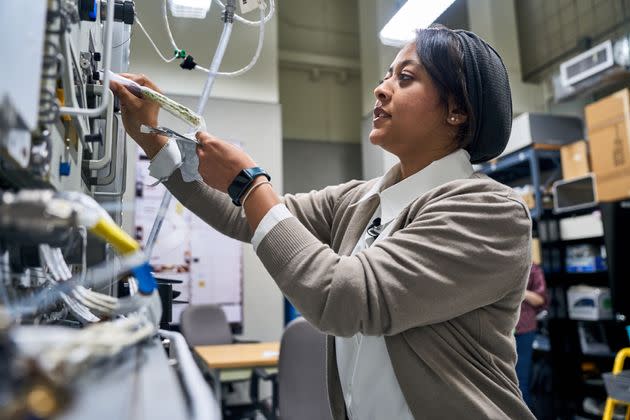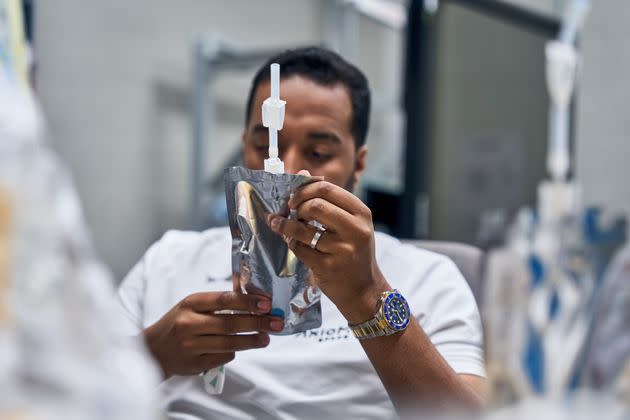5 Types Of Food Astronauts Avoid Eating In Space — And Why

If you make the mistake of eating a gassy chickpea salad for lunch at the office, you might feel a little rumbling in your stomach during your afternoon meetings. But if your job is located in outer space, the consequences are a little more serious.
Astronauts have some degree of food choices, but the foods are often packed months ahead of time. On top of that, astronauts have to figure out how to eat in microgravity when their food and utensils can float up off the plate.
But with all the advances in food technology, there are some foods that are just terrible in space.
Why should we concern ourselves about what astronauts eat in space? Vickie Kloeris, a food scientist and retired manager of space food systems for NASA, said, “If you look at the history of the space program, humanity in general has benefited from the technologies that have come out of the space program.” So figuring out how to keep astronauts healthy, happy and well-fed is an essential part of any space mission.
Turns out, space experts have five types of foods that they would advise against consuming in space.
1. Items With The Highest Risk Of Foodborne Illness
Anyone who has had the misfortune of having food poisoning has no desire to repeat the experience. “Nothing would be more miserable than having vomiting or [worse] in orbit,” Kloeris said. Microgravity would make things very messy and smelly, all in close quarters.
Many foods can be a risk for food poisoning, including undercooked meat or seafood, unpasteurized milk products and unwashed fruits and vegetables. Since the International Space Station has no dedicated food refrigerator, everything needs to be shelf-stable, explained Kloeris, who’s also the author of ”Space Bites: Reflections of a NASA Food Scientist.”

There are eight general categories of food that astronauts can eat according to NASA. First, there’s rehydratable food, where water has been removed and can be rehydrated before eating, like oatmeal, rice, ramen and powdered beverages. Thermostabilized foods are processed with heat and include food items like canned fish, fruit and vegetables. There are intermediate moisture foods, which are foods that have some water removed and can include dried fruit and jam.
Next there are irradiated foods, which have been exposed to ionizing radiation (it’s often used with meat products). Next are frozen foods, like chicken pot pie, and natural form foods that come in ready-to-eat packages, like nuts and granola bars. The final two categories are fresh foods, which includes unprocessed food like vegetables or fruit (these have to be consumed quickly); and then refrigerated foods, like milk products.
Since everything needs to be shelf stable, NASA errs “on the side of being conservative on their microbiological requirements to prevent” food poisoning, Kloeris explained. Nothing is left to chance; all food is tested for safety and taste-tested by astronauts themselves. A nutritionist reviews the astronaut’s preferred menus to ensure they have a balanced meal.
On top of NASA’s rigor with astronaut food itself, the agency requires astronauts to quarantine seven days before launch to keep the crew healthy. That also means that the astronauts do not eat out or at home, “as this increased their exposure to others as well as their chances of contracting a foodborne illness,” Kloeris said in her book.
2. Military-Style Ready-To-Eat Meals
Meals Ready To Eat (MREs) are self-contained, shelf-stable rations used by the United States military. But unfortunately, they could wreak major havoc in space.
MREs are high in salt and fat, which is important for the military since it provides salt to replace electrolytes sweated out in the desert and a lot of calories in a compact space, Kloeris explained. But the high salt content would worsen one of the known side effects of microgravity — bone density loss. Without the constant push of gravity, humans have been found to lose bone density while in space. NASA explains: “For every month in space, astronauts’ weight-bearing bones become roughly 1% less dense if they don’t take precautions to counter this loss.”
Significant exercise helps reduce bone density and muscle weakening, but diet plays a role. Salt can exacerbate bone loss — Kloeris said the first thing your doctor will tell you if you have osteoporosis is “do not eat a high-salt diet.”

3. Crumbly Food
Nothing is quite as satisfactory as the crunch of a crisp potato chip. But chips, breads and other foods that produce crumbs are risky in space.
It all comes down to microgravity. On Earth, crumbs just fall to the floor. But in space, they float and create a mess. Jordan Bimm, a space historian and professor of science communication at the University of Chicago, noted that crumbs could get into air filters, instruments on board and even astronauts’ eyes. In 1965, astronaut John Young got in trouble for smuggling a corned beef sandwich into space in Gemini III, but he only ate a small amount for fear of the crumbs getting everywhere.
While there have been attempts to bring Pringles and other crispy items into space, it generally ended up not worth the mess and anxiety. Instead, astronauts predominantly use tortillas in place of bread. Other options are bite-sized crackers and cookies that can be eaten whole without many crumbs.
4. Bland Food
No one particularly likes bland food, but it is a particular issue in space. Dr. Michael Harrison, chief medical officer for Axiom Space, noted that “due to shifts in bodily fluids in microgravity, the astronauts often have a sense of facial and sinus congestion. This has an impact on their sense of smell and taste.” Hot sauces, like Tabasco or Sriracha, are particular favorites because they add a strong flavor to their meals.
But it is not just a matter of wanting to taste their food. Not only does food provide nutritional benefits, but eating tasty food also has psychological benefits. ”What combines everyone together? It is food,” explained Stephanie Wan, strategic partnerships adviser in support of the Deep Space Food Challenge of the Methuselah Foundation. Food brings the crew together and encourages social bonding and team building, Kloeris noted.
In the beginning of the U.S. space program, NASA was fairly utilitarian when it came to food; the agency’s concern was providing calories and reducing the weight of the food for the astronauts, explained Richard Foss, culinary historian and author of ”The Air and Space: The Surprising History of Food and Drink in the Skies.” The agency was not even sure if humans could eat in space. The challenge was to make something compact, easily usable by someone in gloves — since astronauts lived in their suits in the beginning years of the program — that someone could squeeze into their mouth, bypassing the nose.
On top of it all, it was going to be cold since the capsules were unheated, Foss noted. And the first foods sent up were mashed potatoes or pureed spaghetti.
“If you think of holding your nose and eating something straight from the refrigerator, you’ll get an idea of how enjoyable this is,” Foss pointed out. As a result, astronauts hated eating and came down to Earth dehydrated, hungry and disoriented, which is a significant problem in keeping astronauts healthy and happy.
5. Alcohol
Having a glass of bubbly sounds like a perfect thing to drink while gazing back on the earth. But NASA and the International Space Station have banned alcohol. Kloeris noted that the ban was initially due to safety concerns; if we don’t want pilots and train conductors drinking on the job, we probably don’t want astronauts buzzed or drunk in a complicated apparatus like a space vessel. Property damage in space would be a huge problem.
In time, NASA learned that when recycling water and air, ethanol does not break down. Kloeis noted that “when ethanol gets in the air, it becomes a pollutant in the air system and then the water system.” But of course, even though it poses a risk, an unofficial bottle of liquor or two have made it into space, like cognac with the Russian cosmonauts.
More About What Astronauts DO Eat
It is not all doom and gloom when it comes to food. Astronauts do have options; Kloeris pointed out that astronauts have over 200 different foods and beverages available in the NASA program. Due to regular shipments to the International Space Station, astronauts can get some fresh fruits and vegetables, and sometimes even frozen treats. Wan said that the first Korean astronaut, Soyeon Yi, brought kimchi to space in 2008. Harrison noted that Axiom has brought a variety of foods into space, including “jamon de Bellota, dates, Arabic coffee, turron de Alicante, Swedish candies and Turkish delights.”
But long-term space travel to Mars and beyond will need innovative solutions to keep astronauts happy and healthy. Thanks to the work of companies and competitions like the Deep Space Food Challenge, we will see some incredible technologies that may impact people both on Earth and space. And maybe someday astronauts may be able to safely enjoy a corned beef sandwich with thick bread.